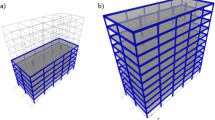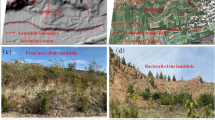Abstract
The parameters of existing roller-compacted concrete (RCC) dam construction simulation are usually fixed based on experience while the actual construction conditions of an RCC dam change during the process of the project. The simulation accuracy of an RCC dam is therefore reduced because the change has not been considered. A new method for RCC dam construction simulations based on real-time monitoring is presented in this paper. First, real-time monitoring technology is used to collect and analyze the actual construction information. Second, meteorological data obtained from the real-time monitoring system are analyzed using the fuzzy average function method, and the weather conditions of the next stage are forecasted. Then the construction schedule simulation model is updated via the Bayesian update method. Results of the analysis are used as the input to the construction simulation parameters, and the construction simulation is performed. A real-world engineering example is presented to compare the simulation results with the actual construction schedule. The results demonstrate that the method can effectively improve the accuracy and real-time performance of construction simulations.
摘要
目的
碾压混凝土坝施工过程中施工仿真参数会随着施工现场环境变化而变化。本文探讨实时监控方法获取的施工信息对施工进度仿真的影响,研究碾压混凝土坝施工仿真参数自适应更新方法,提高施工仿真的精度。
创新点
1. 通过碾压混凝土坝施工信息实时获取技术,分析计算碾压混凝土坝施工仿真参数;2. 利用贝叶斯更新技术对施工仿真参数进行更新;3. 利用模糊均生函数对坝区短期降雨量进行预测;4. 建立基于实时监控的碾压混凝土坝施工仿真模型,对碾压混凝土坝施工过程进行仿真并与实际施工进度对比。
方法
1. 通过实地采集,获取碾压混凝土坝施工过程中实时施工信息(图2);2. 通过理论推导,构建施工仿真参数先验分布均值和方差与后验分布均值和方差之间的关系,得到施工仿真参数更新方案(公式(16)和(17));3. 通过理论推导,利用已知坝区降雨量数据预测未来短期内的降雨情况(图5);4. 通过仿真模拟,得到施工仿真参数更新后的仿真成果并将其与实际施工进行对比,验证本方法的有效性和准确性。
结论
1. 施工仿真参数的准确性对碾压混凝土坝施工仿真结果准确性有很大影响;2. 可以利用贝叶斯更新技术对施工仿真中的仿真参数进行更新,利用模糊均生函数对坝区短时期内降雨量进行预测;3. 运用基于实时监控的碾压混凝土坝施工仿真方法对碾压混凝土坝施工过程进行仿真,仿真结果与实际施工进度之间的偏差明显减少,仿真准确性明显提高。
Similar content being viewed by others
References
Akhavian R, Behzadan AH, 2012. An integrated data collection and analysis framework for remote monitoring and planning of construction operations. Advanced Engineering Informatics, 26(4):749–761. https://doi.org/10.1016/j.aei.2012.04.004
Akhavian R, Behzadan AH, 2013. Knowledge-based simulation modeling of construction fleet operations using multimodel-process data mining. American Society of Civil Engineers, 139(11):755–768.
Anderegg R, von Felten D, Kaufmann K, 2006. Compaction monitoring using intelligent soil compactors. Proceedings of GeoCongress: Geotechnical Engineering in the Information Technology Age, p.41–46. https://doi.org/10.1061/40803(187)41
Banks J, 2005. Discrete Event System Simulation, 4th Edition. Pearson Education India, NJ, USA.
Chang HT, Zhong DH, Wang SQ, 2013. The whole process simulation of the construction progress of the roller compacted concrete dam with the dynamic combined warehouse. Journal of Tianjin University, 46(1):29–39 (in Chinese).
Cui B, 2010. Integrated Theory and Application of Construction Quality Monitoring System for Core Rock Fill Dam. PhD Thesis, Tianjin University, Tianjin, China (in Chinese).
Cui B, Zhong DH, Zhang P, et al., 2009. The application of computer graphic technology on monitoring roller compaction quality of rock-fill dam. 6th International Conference on Computer Graphics, Imaging and Visualization, p.520–524. https://doi.org/10.1109/CGIV.2009.26
Dong H, Zhao C, 2013. Simulation and optimization research on the operating system of the construction of the RCC dam. Water Conservancy and Hydropower Technology, 44(1):79–82 (in Chinese).
Gelman A, Carlin J, Stern H, et al., 2004. Bayesian Data Analysis, 2nd Edition. Chapman & Hall/CRC, USA, p.283–310.
Han S, Lee S, Halpin D, 2005. Productivity evaluation of the conventional and GPS-based earthmoving systems using construction simulation. Construction Research Congress. https://doi.org/10.1061/40754(183)35
Han S, Lee S, Hong T, et al., 2006. Simulation analysis of productivity variation by global positioning system (GPS) implementation in earth moving operations. Canadian Journal of Civil Engineering, 33(9):1105–1114. https://doi.org/10.1139/l05-124
Hossain M, Mulandi J, Keach L, 2006. Intelligent compaction control, airfield and highway pavements: meeting today’s challenges with emerging technologies. Processing of the Airfield and Highway Pavement Specialty Conference, p.304–316.
Jurecha W, Widmann R, 1973. Optimization of dam concreting by cable-cranes. 11th International Congress on Large Dams, p.43–49.
Liu DH, Cui B, Liu YG, et al., 2013. Automatic control and real-time monitoring system for earth-rock dam material truck watering. Automation in Construction, 30:70–80. https://doi.org/10.1016/j.autcon.2012.11.007
Liu YX, Zhong DH, Cui B, et al., 2015. Study on real-time construction quality monitoring of storehouse surfaces for RCC dams. Automation in Construction, 49:100–112. https://doi.org/10.1016/j.autcon.2014.10.003
Lu M, Dai F, Chen W, 2007. Real-time decision support for planning concrete plant operations enabled by integrating vehicle tracking technology, simulation, and optimization algorithms. Canadian Journal of Civil Engineering, 34(8):912–922. https://doi.org/10.1139/l07-029
Luo W, 2009. RCC dam simulation of petri network coupling model based on process queue. Journal System Simulation, 21(19):6280–6283 (in Chinese).
Mooney MA, Rinehart RV, 2007. Field monitoring of roller vibration during compaction of subgrade soil. Journal of Geotechnical and Geoenvironmental Engineering, 133(3):2571265.
Navon S, 2005a. Field experiments in automated monitoring of road construction. Journal of Construction Engineering and Management, 131(4):487–493. https://doi.org/10.1061/(ASCE)0733-9364(2005)131:4(487)
Navon S, 2005b. A model for automated monitoring of road construction. Construction Management and Economics, 23(9):941–951. https://doi.org/10.1080/01446190500183917
Reclus F, Drouard K, 2010. Geofencing for fleet & freight management. International Conference on Intelligent Transport Systems Telecommunications, p.353–356. https://doi.org/10.1109/ITST.2009.5399328
Song L, Eldin NN, 2012. Adaptive real-time tracking and simulation of heavy construction operations for lookahead scheduling. Automation in Construction, 27:32–39. https://doi.org/10.1016/j.autcon.2012.05.007
Song S, Zhang A, Wang J, et al., 2015. Screen: stream data cleaning under speed constraints. ACM SIGMOD International Conference on Management of Data, p.827–841. https://doi.org/10.1145/2723372.2723730
Straub D, Papaioannou I, 2015. Bayesian updating with structural reliability methods. Journal of Engineering Mechanics, 141(3):04014134. https://doi.org/10.1061/(ASCE)EM.1943-7889.0000839
Vahdatikhaki F, Hammad A, 2014. Framework for near realtime simulation of earthmoving projects using location tracking technologies. Automation in Construction, 42: 50–67. https://doi.org/10.1016/j.autcon.2014.02.018
Vahdatikhaki F, Hammad A, 2015. Optimization-based excavator pose estimation using real-time location systems. Automation in Construction, 56:76–92. https://doi.org/10.1016/j.autcon.2015.03.006
Wei FY, Cao HX, 1993. A fuzzy mean generating function (FMGF) model and its application. Chinese Academy of Meteorological Sciences, 19(2):7–11 (in Chinese).
White DJ, Thompson MJ, Jovaag K, et al., 2006. Filed Evaluation of Compaction Monitoring Technology: Phase II. Lowa State University, USA.
Zhang C, Hammad A, Rodriguez S, 2012. Crane pose estimation using UWB real-time location system. Journal of Computing in Civil Engineering, 26(5):625–637. https://doi.org/10.1061/(ASCE)CP.1943-5487.0000172
Zhang SR, Du CB, Sa WQ, et al., 2014. Bayesian-based hybrid simulation approach to project completion forecasting for underground construction. Journal of Construction Engineering and Management, 140(1):04013031.
Zhong DH, Cui B, Liu DH, 2011. Real-time compaction quality monitoring of high core rockfill dam. Science China Technological Sciences, 54(7):1906–1913. https://doi.org/10.1007/s11431-011-4429-6
Zhong DH, Chang H, Li MC, 2012a. Dynamic simulation of high RCC dam construction. International Journal of Hydropower Dams, 19(5):70–74 (in Chinese).
Zhong DH, Zhong GL, Cui B, 2012b. The theory and application of microclimate information real-time monitoring and control RCC dam. Water Conservancy and Hydropower Technology, 43(1):84–87 (in Chinese).
Zhong DH, Chang HT, Wang SQ, et al., 2013. The whole process simulation of the construction progress of the roller compacted concrete dam with the dynamic combined warehouse. Journal of Tianjin University, 46(1): 29–37 (in Chinese).
Zhong DH, Hu W, Wu BP, et al., 2017. Dynamic time-costquality tradeoff of rockfill dam construction based on real-time monitoring. Journal of Zhejiang University-SCIENCE A (Applied Physics & Engineering), 18(1):1–19. https://doi.org/10.1631/jzus.A1600564
Zhong GL, 2012. The Theory and Application of Construction Quality Real Time Monitoring of the Construction Quality of RCC Dam. PhD Thesis, Tianjin University, Tianjin, China (in Chinese).
Zhou YH, Zhao CJ, 2008. Optimizing resource allocation based visual construction simulation system for an RCC dam. Progressing World Hydro Development, p.767–775.
Author information
Authors and Affiliations
Corresponding author
Additional information
Project supported by the National Natural Science Foundation of China (Nos. 51439005 and 51409188) and the Science Fund for Creative Research Groups of the National Natural Science Foundation of China (No. 51621092)
Rights and permissions
About this article
Cite this article
Wang, Qw., Zhong, Dh., Wu, Bp. et al. Construction simulation approach of roller-compacted concrete dam based on real-time monitoring. J. Zhejiang Univ. Sci. A 19, 367–383 (2018). https://doi.org/10.1631/jzus.A1700042
Received:
Revised:
Accepted:
Published:
Issue Date:
DOI: https://doi.org/10.1631/jzus.A1700042
Key words
- Roller-compacted concrete (RCC) dam
- Construction simulation
- Real-time monitoring
- Bayesian update
- Fuzzy mean generating function




